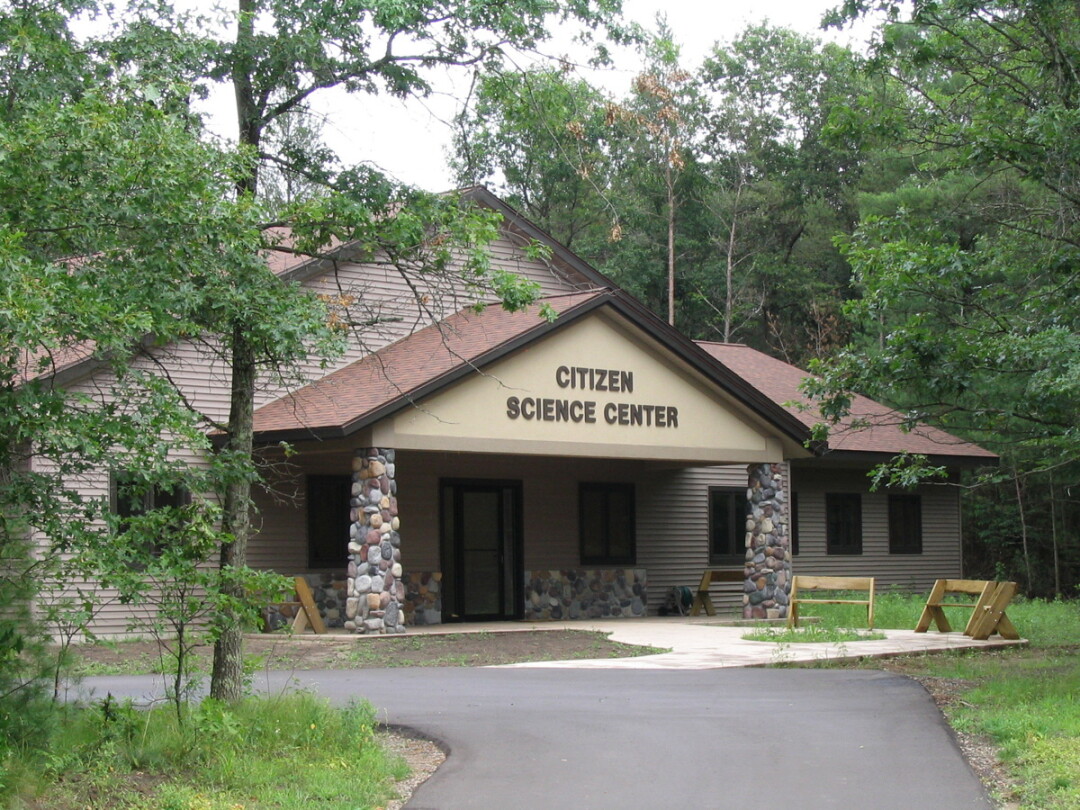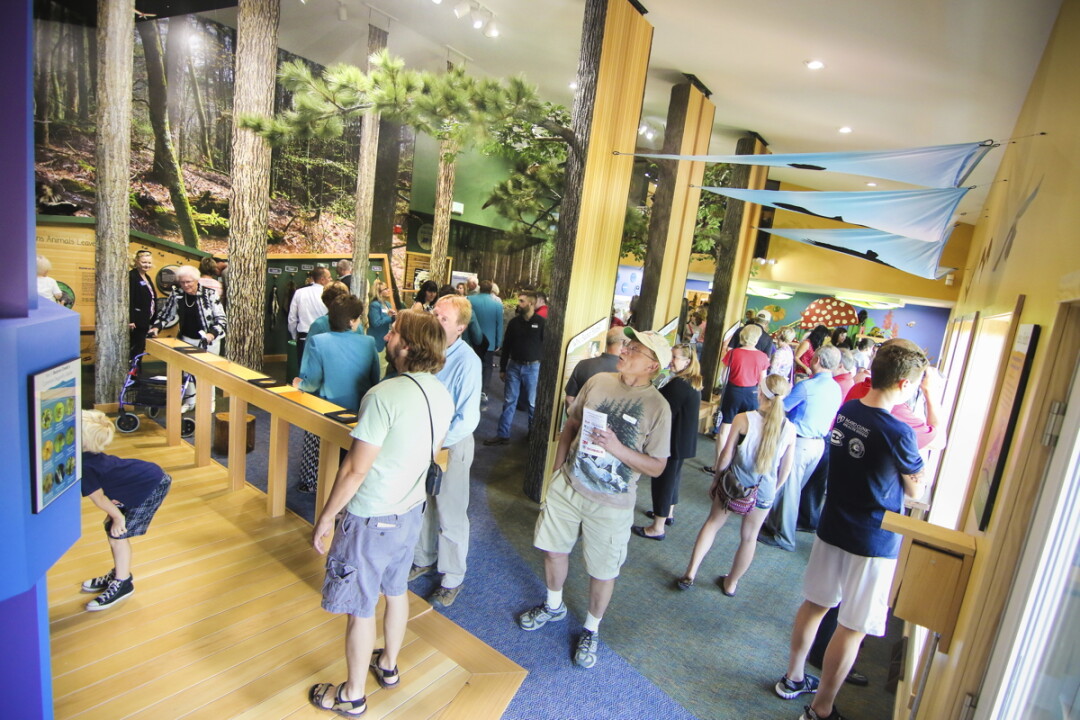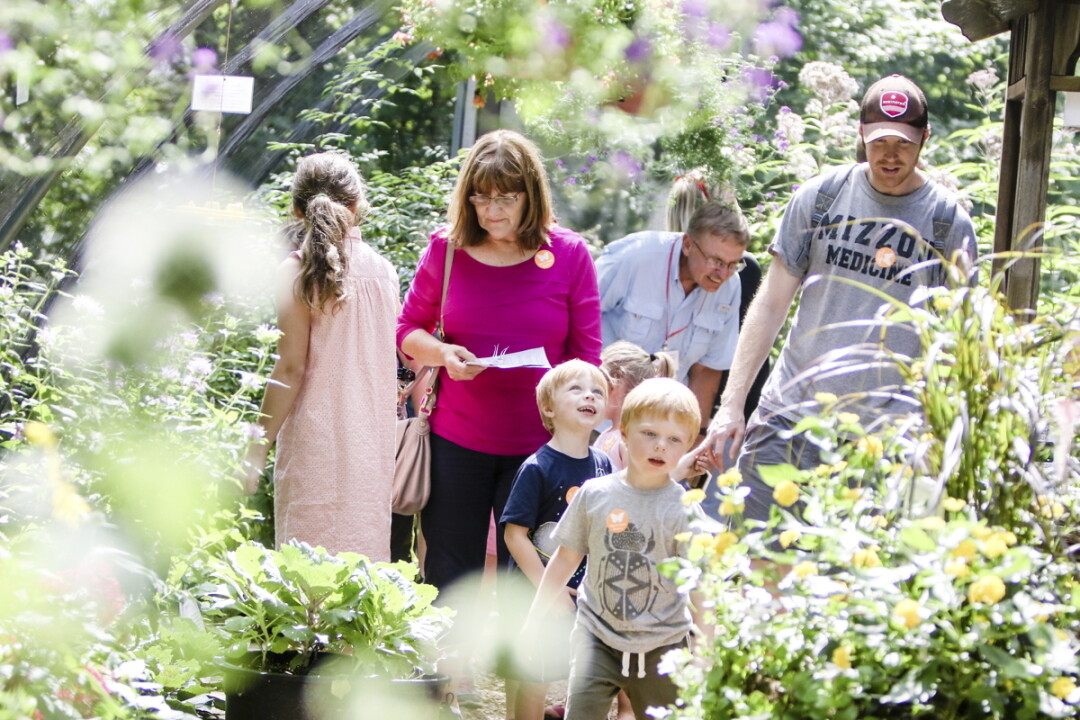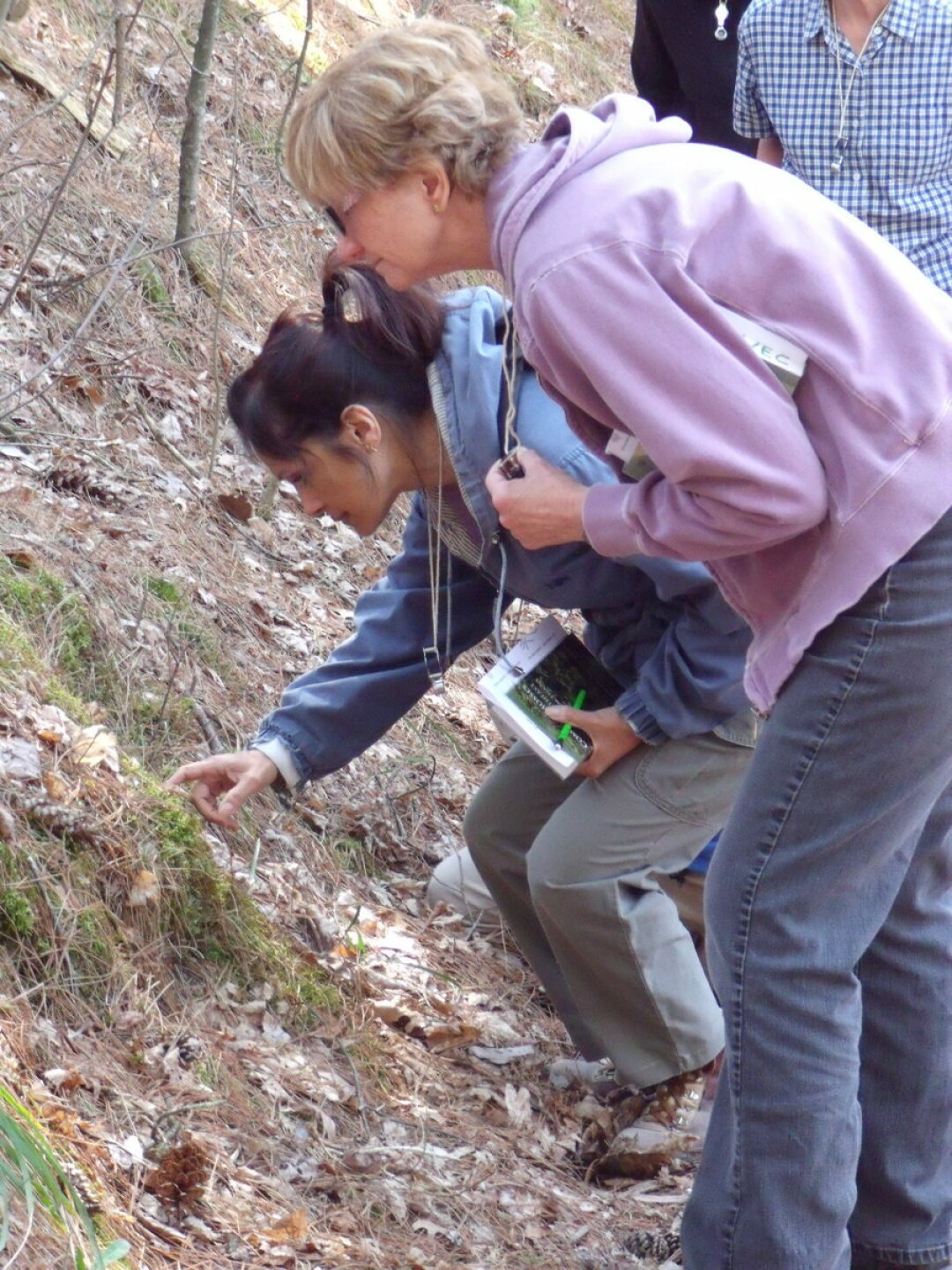FEATURE: It's Only Natural
Beaver Creek Reserve isn’t just for kids. It offers tons of opportunities for adults to fall in love with nature, too.
Amanda Luft, photos by Andrea Paulseth |

Did you know there are 38 kinds of mollusks living in the Chippewa River? You can see shiny examples of them all in a display case at Beaver Creek Reserve. I discovered this fact during the first week of June, when I attended Wisconsin Master Naturalist training.
A naturalist is someone who teaches others about the delights and challenges of the natural world. The Wisconsin Master Naturalist training at Beaver Creek Reserve (S1 County Road K, Fall Creek) inspired all of us nature-loving citizens (ranging in age from 24 to 72) to cultivate a sense of place and ownership of the Chippewa Valley.
The Wisconsin Master Naturalist program provides an overview of Wisconsin’s natural resources, focusing on topics such as nature interpretation (helping people connect to a place), climate, aquatic plants and animals, wildlife, and human influences. The program’s ultimate goal is to educate and train service-minded adults interested in volunteering in environmental stewardship, education, and research. In 2016 alone Wisconsin Master Naturalists volunteered 17,454 hours of service and reached 52,119 people through volunteer-led programs.
This year was the first time the training was held at Beaver Creek Reserve, 400 acres of diverse habitat including upland woods, river bottom forests, wetlands, and savannah areas. The Eau Claire River, Beaver Creek, and Deinhammer Creek all run on the property north of Fall Creek.
Many people who grew up in the Chippewa Valley have fond memories of attending summer camp or youth group outings at Beaver Creek Reserve. These same adults enjoy bringing their children and grandkids to the reserve to connect with nature.
What you may not know is that Beaver Creek Reserve is a paradise for any nature-loving adult. Just because you’ve outgrown your Scout uniform or the kids have left the nest doesn’t mean you have to stay home and miss out on all the happenings at Beaver Creek. Here are some of the facilities, programs, and activities at Beaver Creek designed for nature-loving grown-ups.

Hobbs Observatory
Beaver Creek’s remote location is great for stargazing because there’s very little light pollution. The Hobbs Observatory, on the north side of Beaver Creek, houses two telescopes owned by UW-Eau Claire. The Chippewa Valley Astronomical Society, a group of amateur astronomy enthusiasts, hosts the Hobbs Observatory Astronomical Series the third Saturday of each month at 8pm. The public is welcome to a 45- to 60-minute astronomy program, followed by an opportunity to view the night sky through one of the telescopes (weather and clouds permitting). The astronomy group also hosts Northwoods Starfest, a regional star party that attracts amateur astronomers from across the Midwest. For more information, visit their website at cvastro.org.
Wise Nature Center
Located on the south side of Highway K, the Nature Center houses the newly remodeled Scheel’s Discovery Room (which features hands-on activities for kids), binoculars for birdwatching opportunities, and a nature-themed gift shop. You can also find Gentle Yoga classes here, too, as well as equipment rentals and restrooms.

Citizen Science Center
The Chippewa Valley is home to the only Citizen Science Center in the state. The Citizen Science Center at Beaver Creek was established in 2003 to help professional scientists with limited resources study and monitor Wisconsin flora and fauna. There are more acres of habitats than state- and county-employed biologists can study, so citizen scientists fill in the gaps by learning basic scientific techniques to help provide important data that may otherwise go missing.
A few of the programs at the CSC include ...
Bird Banding
The bird-banding program at Beaver Creek has been going strong for more than 20 years. Volunteers hang “mist nets” – virtually invisible mesh nets that allow the humane capture of birds. The bird bander then gently holds the bird and bands its leg with a lightweight metal band stamped with a unique number, kind of like a bird Social Security number. They also record data such as age, sex, and species. Banded birds are often recorded several times, and all data is sent to the U.S. Geological Survey Bird Banding Laboratory in Laurel, Maryland. This program helps monitor bird populations, life spans, and migration patterns, among other data. Changes in these patterns, such as a sudden drop in a species population, can help biologists identify threats to Wisconsin birds both at home and abroad.
American Kestrel Nest Box Monitoring Research
The American Kestrel is the smallest falcon in North America. The program monitors 30 nesting boxes in Eau Claire and Chippewa counties, mostly along Interstate 94. The program runs from March to July each year, and people are welcome to observe the monitoring process, with a high likelihood of seeing a kestrel up close. If you’re interested in observing kestrels, call Beaver Creek to make arrangements.
Bluebird Restoration Project
Volunteers monitor bluebirds in Eau Claire County and enter data into an online database. The goals of this program are to increase the number of bluebirds and other cavity nesting birds in the area and to heighten awareness and knowledge about bluebirds and their habitat. You can set up your own bluebird nest box or boxes in your yard. Beaver Creek offers bluebird boxes for sale in the gift shop as well as programs on how to build your own.

Stream Monitoring
From May through September, citizen scientists test water quality and clarity, check stream levels, monitor for invasive species, and assess the habitat. This sounds boring, but it’s actually a lot of fun. During the Wisconsin Master Naturalist training, we assessed the health of Deinhammer Creek by walking through the stream wearing rubber boots and turning over rocks and logs to gather aquatic invertebrates. I’m grateful to report that the creek gets a clean bill of health.
Acoustic Bat Monitoring
Wisconsin has seven bat species, four of which are classified as “threatened.” Of the remaining three, one is listed as a Species of Greatest Conservation Need and the other two are classified as “rare mammals” in the state. Volunteers learn how to monitor for bats using a portable monitoring device, and report their findings to a statewide database that helps state bat biologists. You can then take night hikes, discovering bats and reporting what you find. The next monitoring session and training will be 7:30-9:30pm on Saturday, July 15. Registration is required.
Being a citizen scientist is simple, but it does require an ongoing commitment. You don’t have to travel to Beaver Creek; some projects can be done in your own backyard or close to home. If you’re interested in contributing to this valuable research, contact Beaver Creek Reserve.
If want to learn more about the world of the Chippewa Valley but aren’t sure you want to go on full-on citizen scientist, there are plenty of programs at Beaver Creek that can pique your curiosity. Many require advanced registration. For more details and a full list of programs, visit the “Events” tab at the Beaver Creek Reserve website (beavercreekreserve.org).

Programs for Adults at Beaver Creek Reserve
Hobbs Observatory Astronomical Series
On clear Saturday nights from May through October, take a look through the telescope and see what’s happening in the galaxy. Program times vary according to the sunset. In June and July the program runs from 10pm to midnight. August and September programs run from 9-11pm. In October you can see the stars up close from 8-10pm.
Summer Wild Edibles
Friday July 28, 1:30-4pm. Discover the art of foraging for wild edible plants with Beaver Creek Naturalist Jim Schwiebert. Take a hike and find some common, wild edible plants. The program includes a list of plants to try.
The Butterfly House and Beaver Creek Butterfly Festival
The Butterfly House opened Wednesday July 5, and will stay open until Labor Day weekend. The large screened-in house is a temporary home to monarch butterflies, which Beaver Creek staff raise from caterpillars, as well as a variety of native species they catch with nets. The house is stocked with native plants and foods, and the butterflies are safe from predators while they live there. The Butterfly Festival is noon-3:30pm Sunday Aug. 6, and includes half-hour mini-seminars on Wisconsin butterflies, raising your own butterflies, butterfly gardening, and other topics. There will be guided tours of the butterfly house and caterpillar lab, games, crafts, and butterfly sundaes!
Master Naturalist Training at Beaver Creek, 2018
The Wisconsin Master Naturalist program is put on through the UW-Madison Environmental Resources Center. For more information, contact Beck Sapper at becky.sapper@uwex.edu or visit the website at http://erc.cals.wisc.edu/programs/wisconsin-master-naturalist/.

Other kinds of classes offered to adults at Beaver Creek include, but are not limited to ...
Beekeeping, from getting started to learning how to overwinter your beehive. Training is provided by members of the Chippewa Eau Claire Beekeepers Club.
Phenology hikes geared toward adults 55 and older. Phenology is the study of seasons in relation to climate and plant and animal life.
Discovering dragonflies and damselflies with members of the Wisconsin Dragonfly Society.
Hula hoop exercise and empowerment class geared toward women and girls, ages 16 and up.
How to raise your own monarch butterflies at home. Loss of habitat, severe storms in wintering areas, summer drought, and herbicide and pesticide use have all helped to reduce monarch butterfly populations across the state. But humans can lend them a helping hand by raising caterpillars to butterflies.
Breeding Bird Atlas Blitz, in which participants search Beaver Creek for as many breeding birds as possible, discovering along the way how to recognize bird courtship and nesting behavior, and to watch the birds as they prepare for the arrival of their young.
Discover aquatic invasive species such as zebra mussels and Eurasian water milfoil and how to prevent their destruction of Wisconsin lake and river ecosystems.
The Trails at Beaver Creek Reserve
And remember, you’re always welcome to visit the reserve and walk any of the 9 miles of beautiful trails. Trout fishing is allowed on the property with a valid fishing license and trout stamp. In the winter the trails on the south side are open for snowshoeing, while the north side trails are groomed for cross-country skiing. There is no entrance fee for Beaver Creek Reserve members; nonmembers pay $3.
The staff and volunteers at Beaver Creek are true stewards of the Chippewa Valley, providing dozens of ways for adults and grown-up children to indulge a love of this place we call home, preserve and appreciate nature, and enjoy lifelong learning. See you in the woods!






















